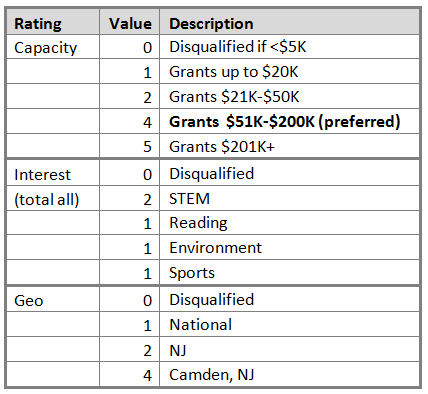 Let’s not be shortsighted. Information technology has improved rapidly and many of the tasks that fall under the prospect research umbrella are automated. They are. Wealth screenings have replaced me as the first course of action in a small organization. They have. No use crying over it. And it’s not going to stop there. So how do we stay relevant in our field?
Let’s not be shortsighted. Information technology has improved rapidly and many of the tasks that fall under the prospect research umbrella are automated. They are. Wealth screenings have replaced me as the first course of action in a small organization. They have. No use crying over it. And it’s not going to stop there. So how do we stay relevant in our field?
Find >> Analyze >> Synthesize
We researchers like to use the word analysis to justify our role, but we need to do even more than that. According to Merriam Webster, analysis is an explanation of the nature and meaning of something. But synthesis is something that is made by combining different things such as ideas.
Yes, we need to analyze information to point out the pieces that are relevant to fundraising – whether that is in a profile, trends in our relationship management system, or statistical analysis of our database.
But what if we could learn to take it a step further and routinely synthesize the information, churning out insights that our development officers can act on? It would be another step towards job security, that’s what!
What might that look like?
Charlie is a good prospect for a legacy gift. He has announced he will be retiring in five years. When he retires he will receive a lump sum payment of all of his restricted stock units in the company’s deferred compensation plan, which is currently valued at around $45 million. He has been a top executive for fifteen years and is not likely to be relying upon that sum for retirement and may be interested in ways to offset tax liabilities.
You are not just analyzing and preparing the pieces of information in that profile, you are doing that PLUS putting the different pieces together to create a new idea: he is a good legacy gift prospect.
.
.
.
.
.
.
.
Janice is a good prospect to leverage for peer giving. She is past president of the local Chamber of Commerce and has the most relationships with others in your prospect pool. She has a high wealth rating and served as co-chair for the campaign of Local Organization.
Applying external data to evaluate the prospects in your development officer’s pipeline is not enough anymore. Not if you are capable of pulling those external pieces together into a recommended action that will move her entire pipeline forward.
.
.
.
.
.
We should run an additional analysis to identify women major gift prospects. In this table are the prospects that have the highest predictive value for making a major gift to our campaign, but only one percent of them are women. Sixty-five percent of our active donors are women and as of 2009 women controlled 39% of U.S. wealth with predictions of that number increasing.
Sometimes the method of analysis is technically accurate and perfectly defective. It takes a curious mind and some sincere synthesis to process information in both micro and macro environments and make a recommendation.
.
.
.
.
.
.
Practice, Practice, Practice … and Be Bold!
It’s likely that no-one has ever explicitly taught you to synthesize the information and provide recommendations. You may have even been made to feel foolish or been chided for providing recommendations in the past.
Be Bold! Oil your feathers and let the water roll off of them! You won’t get better at this skill if you don’t practice. And when your insights and recommendations are shot down (and they will be at least once because development officers don’t always share what they know with us), shake off the embarrassment and write down what you learned.
When you recognize that you, I mean you the individual, are a really amazing person, then you can also recognize that you may or may not be good at providing insights and recommendations. That’s okay. You weren’t good at cursive either, until you practiced. (Do children still learn cursive in school?).
So forget your fear of failure and start practicing the art and science of providing insights and recommendations. Synthesize that data baby!
 Did you have a chance to read the
Did you have a chance to read the  I’ve selected three recent articles written by female fundraisers about wealthy women philanthropists. Enjoy!
I’ve selected three recent articles written by female fundraisers about wealthy women philanthropists. Enjoy! Think of your nonprofit like a light bulb and money as the filament. You’ve got plenty of conducting wire to glow for a long time, but are you shining as bright as possible? Is your light reaching as far as it could or are you casting shadows upon donors just out of reach?
Think of your nonprofit like a light bulb and money as the filament. You’ve got plenty of conducting wire to glow for a long time, but are you shining as bright as possible? Is your light reaching as far as it could or are you casting shadows upon donors just out of reach? Sarah Tedesco is Executive Vice President at DonorSearch, a prospect research and wealth screening company that focuses on proven philanthropy. Sarah is responsible for managing the production and customer support department concerning client contract fulfillment, increasing retention rate and customer satisfaction. She collaborates with other team members on a variety of issues including sales, marketing and product development ideas.
Sarah Tedesco is Executive Vice President at DonorSearch, a prospect research and wealth screening company that focuses on proven philanthropy. Sarah is responsible for managing the production and customer support department concerning client contract fulfillment, increasing retention rate and customer satisfaction. She collaborates with other team members on a variety of issues including sales, marketing and product development ideas. Women may be just under half of the world’s population, but they represent 11% of the 2015
Women may be just under half of the world’s population, but they represent 11% of the 2015  Can you imagine if that headline was about you? How would that impact your organization and your fundraising career? Would it be fatal or a blip in the radar?
Can you imagine if that headline was about you? How would that impact your organization and your fundraising career? Would it be fatal or a blip in the radar? Looking back on 2014 I realize that I’ve done quite a few screenings and research verification projects. And that means I’ve had lots of conversations with fundraisers who ask a lot of the same questions. I thought you might like to eavesdrop on some of those Q&A’s!
Looking back on 2014 I realize that I’ve done quite a few screenings and research verification projects. And that means I’ve had lots of conversations with fundraisers who ask a lot of the same questions. I thought you might like to eavesdrop on some of those Q&A’s!

 The future has a way of entering slowly, day-by-day. But sometimes the writing is on the wall. The words I see on the fundraising wall are Data Analytics. Sure, you say, we all know that. But what does it mean to your organization? To you? Answer: Innovate or die.
The future has a way of entering slowly, day-by-day. But sometimes the writing is on the wall. The words I see on the fundraising wall are Data Analytics. Sure, you say, we all know that. But what does it mean to your organization? To you? Answer: Innovate or die.